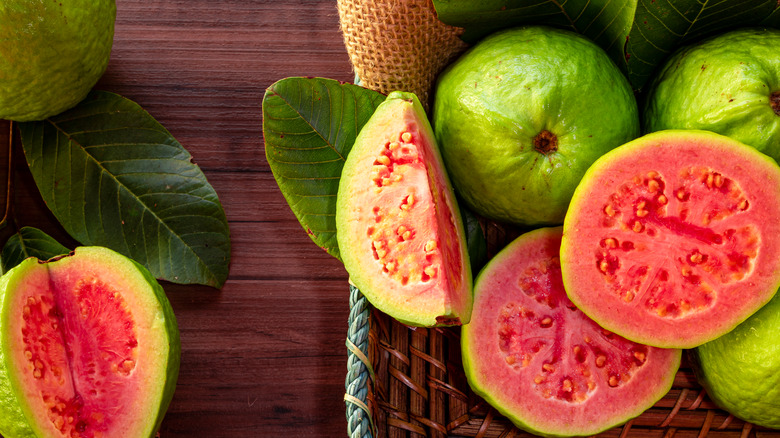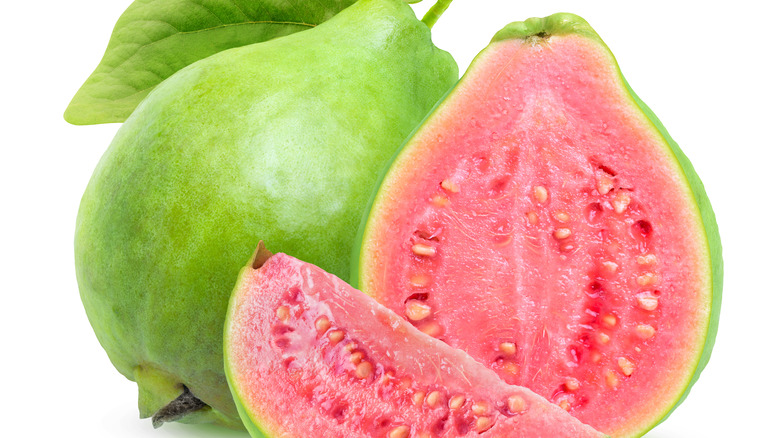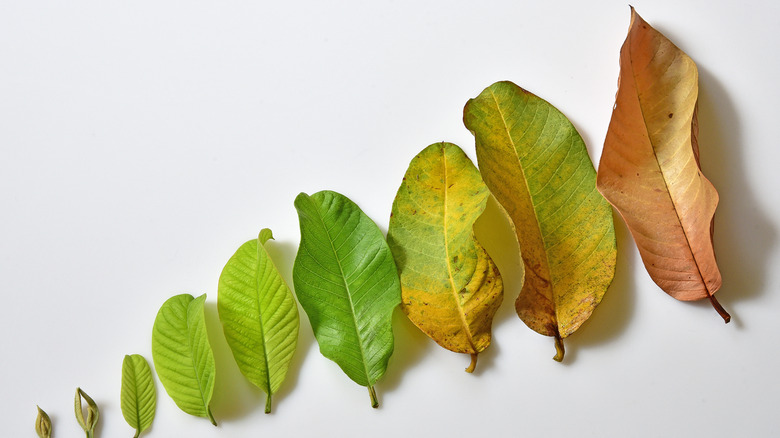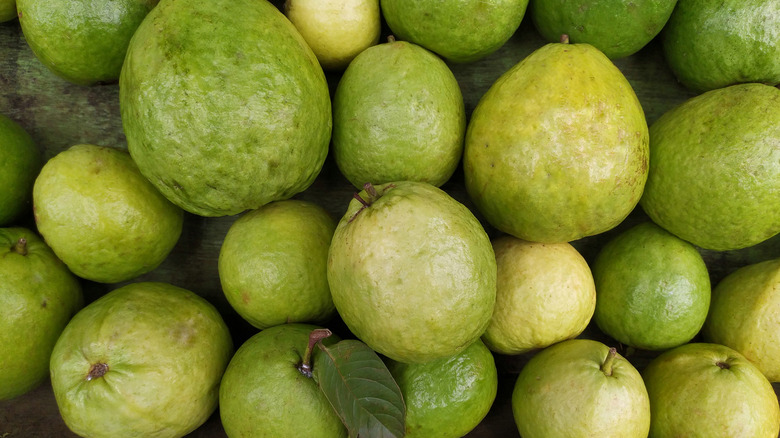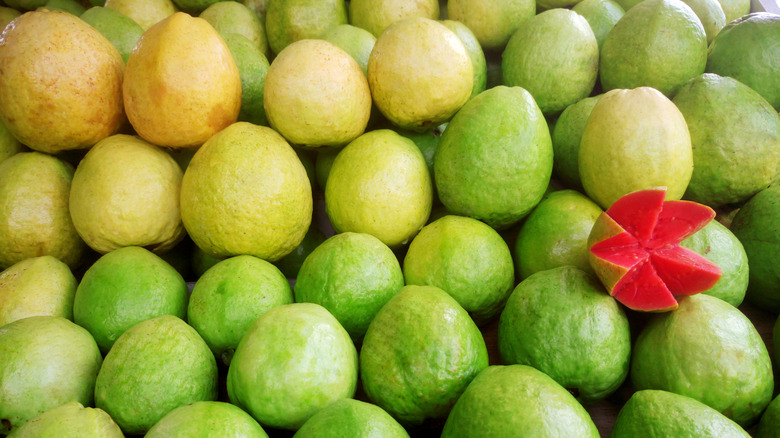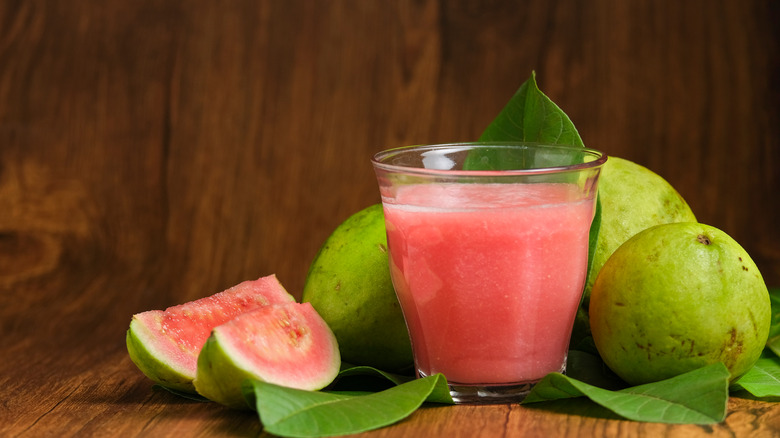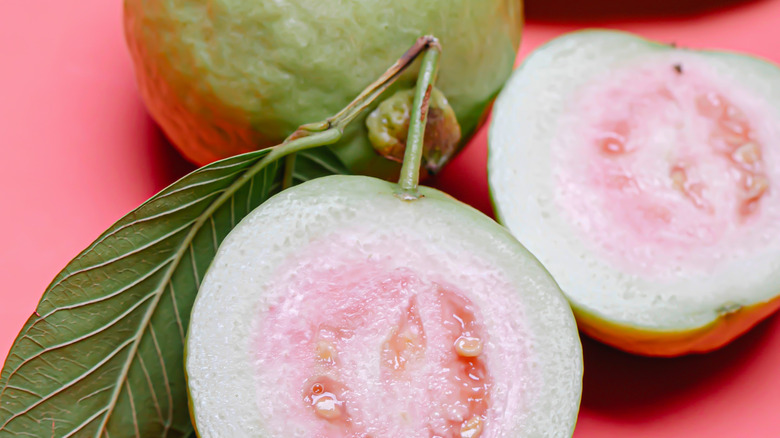What Is Guava And What Does It Taste Like?
Surely you have heard of guava (Psidium guajava) — or have even ordered the ingredient in your smoothies. But, what actually is guava? The food is an edible tropical fruit with a yellow or light green color on the outside, and the seeds are edible and provide several health benefits (via Native Voices).
Additionally, guava is white, dark red, or pink on the inside, and can even be categorized as a "Superfruit." According to Delight Medical & Wellness Center, this term means fruits that are elevated in nutrients and antioxidants. This tropical food is also known for its low amount of carbohydrates and fats, and a high amount of vitamins. Guava is normally consumed fresh as it is believed to come with therapeutic benefits as well.
Consistently found in beverages and jams, guava leaves can be extracted to create an herbal tea. Guava leaf extract is not uncommon due to its many connections to fighting off the flu, high blood pressure, diarrhea, menstrual cramps, osteoarthritis, and cancer (via Medical News Today). Wow, talk about a Superfruit.
What is guava?
Guava belongs to the Psidum of the Myrtaceae family. ScienceDirect explains that this is a family of trees and shrubs with sub-alternate leaves. At around seven to ten meters tall, the branched tree grows small and fragrant leaves at an average of four to ten centimeters long.
The exotic fruit originated in areas of southern Mexico through Central America, but has been around for so long that the exact origin is uncertain. Additionally, guava is common in warm and tropical areas such as Bermuda, southern Florida, the West Indies, and the Bahamas (via Purdue).
Introduced in 1847, early colonizers spread guava throughout many countries, including Guam, Asia, and the African continent. Today, MyRecipes claims that India is the number one producer of the fruit; Mexico is a close runner-up as guava is one of its leading resources. The fruit started being grown commercially in Florida and Hawaii in the 1800s, when it first arrived in America.
Dried vs. Fresh Guava
Dried guava is much more nutritious than one might think. Foodzu claims that this version of the fruit can be medicinal due to its influx of antioxidants; they report that experts have found that guava is a great cure for diarrhea, menstrual pain, vomiting, and coughs. With the caveat that the dried fruit is not a miracle cure, guava is a great source of nutrients.
Additionally, dried guava is also said to be sweeter than fresh guava. Healthline writes that dried guava can be preserved much longer than fresh as well, and pack as much as almost four times the fiber. Essentially, the fruit carries the same amount of nutrients either way; dried fruit is just in a smaller package!
Raw guava is perfect as a snack or dessert, as it can be eaten just like an apple. Due to the fact that the skin and seeds are edible, you may enjoy it completely fresh. Some even eat it with a pinch of salt and pepper as a midday pick me up.
What does guava taste like?
Due to guava's variance in color, the fruit can also have diverse flavors. Each individual fruit has different degrees of sweetness, juiciness, and acidity. Plus, the center of guava is filled with thick yellow seeds but is also very juicy.
The flavor of guava as a mix between a strawberry and a pear, as it has floral undertones and tastes extremely fruity. Still, it is difficult to purchase the same kind of guava every time you're at the supermarket because no two fruits are the same!
One thing to note is that the most popular iteration of guava, which is in its juice form, can be highly caloric and not as beneficial than eating the fruit dried or raw. This is because packaged products tend to have more sugar and less of the fruit's fiber. Therefore, it is important to pay attention to what guava items you are buying.
Where to buy guava
Depending on your location, guava should not be too hard to find. In fact, guava juice is fairly popular at natural food stores or can be ordered in cartons online. Additionally, Walmart and the tropical fruit section of the produce department in a supermarket are normally where you would buy the ingredient.
Typically, guava is located next to mangoes, papayas, kiwis, and other exotic fruits. In order to grab the best one, you will want the exterior of the fruit to be a yellowish color free of any blemishes. Ripe guavas may have a slight pink or orange color as well; just give the fruit a squeeze to see if it is soft.
A soft guava tends to be the sweetest, and the aroma will automatically tell you if the fruit is ripe; there is a noticeable sweet and floral smell that will make this tropical fruit all the more enticing. Once your guava is ripe, you have about two days before it goes bad.
Nutritional information about guava
Here comes the best part about guava: the nutritional benefits. There is no shortage of those when it comes to this exotic fruit. According to Spoon University, Guava boosts your immunity and is one of the richest sources of both vitamin C and A. Potassium and fiber are also plentiful, which is why guava is great for weight loss.
Indeed, weight loss is a factor when it comes to eating guavas because they contain many of the nutrients that the body needs, as noted by Healthline. Therefore, it can be easy to lose extra pounds or maintain your weight by eating this snack. With the high amounts of fiber, guava can also decrease the risk of type 2 diabetes.
Additionally, guava can lower blood sugar levels, boost heart health, benefit your digestive system, and improve your skin. All of the above, please. In fact, one guava alone can supply 12% of your daily recommended daily fiber intake.
Other varieties of guava
The most common varieties of guava include lemon guava, tropical pink guava, tropical white guava, tropical yellow guava, and red Malaysian guava (via MyRecipes). The lemon guava, also known as the apple guava, is the most popular due to its tangy flavor and small size. This type of guava has a pungent smell and lemony taste. Continually, tropical pink guava is, you guessed it, pink on the inside. It is more mild and has a stronger aroma than other kinds of guava. Then the tropical white guava has a light skin and is yellow in the middle; this variant is better used in desserts due to its sweetness.
Tropical yellow or Mexican cream guava is mainly orange with white skin. This type of the fruit is a little less sweet than the others, and is much more juicy as well. Lastly, red Malaysian guava has a pink center surrounded by red skin. It is extremely sweet and sometimes even is utilized as a pretty decoration!
